The Living Palimpsest Profile: An Integrated Assessment Framework for Vernacular Rural Settlements
Abstract
1. Introduction
The Living Palimpsest Profile (LPP): An Innovative Assessment and Action Framework
- How can the palimpsest metaphor be integrated into a sustainability assessment framework to effectively overcome the limitations of static, urban-focused existing models and provide a rigorous, comprehensive diagnosis for vernacular rural settlements?
- Does the LPP methodology possess sufficient contextual sensitivity and robustness to generate distinct and tailored Frameworks of Visions that align with both the specific Sustainable Development Goals (SDGs) and priorities demanded by different local challenges and positive attributes?
2. A Critical Review of Existing Sustainability Assessment Frameworks
2.1. Sustainability Indicators
2.2. Sustainability Rating Tools (SRTs)
2.3. Qualitative Frameworks
3. Materials and Methods
3.1. Development of the Living Palimpsest Profile (LPP) Assessment Model
3.2. Case Study Analysis
4. Results and Discussion
4.1. The Living Palimpsest Report for Korogonianika
4.1.1. Vernacular & Beauty Values
4.1.2. Environment, Infrastructure and Ecology
4.1.3. Social Dynamics
4.1.4. Local Economy
4.2. The Living Palimpsest Report for Velika Hoča
4.2.1. Vernacular & Beauty Values
4.2.2. Environment, Infrastructure and Ecology
4.2.3. Social Dynamics
4.2.4. Local Economy
4.3. Analytical Interpretation of Layered Interactions
4.4. Derivation and Contextual Differentiation of the Frameworks of Visions
4.5. LPP Limitations, Transferability and Digital Operationalization
Developing a GIS-Based Digital LPP
- Vernacular & Beauty Values Layer can enable mapping of the settlement’s history and evolution. It can provide historical/evolution mapping (georeferencing old plans for change detection), the heritage and risk layer (mapping protected sites and natural threats), and the intangible heritage layer (geocoding locations of traditional crafts and cultural practices) to define restoration priorities.
- Environment, Infrastructure and Ecology Layer can fuse essential spatial data to diagnose system vulnerabilities. For example, it can provide infrastructure and accessibility maps (measuring utility networks and service distribution), the environmental constraints layer (identifying protected areas, biodiversity and soil quality), and resource vulnerability mapping (locating critical water sources and ecological stressors).
- Social Dynamics Layer can be used to capture the spatial patterns of community cohesion and change. For example, it can integrate demographic change mapping (geocoding population shifts and migration flows), the social palimpsest layer (visualizing historical locations of social interaction, organization and divisions), and accessibility analysis (revealing inequality in resource distribution among different social groups).
- Local Economy Layer can visualize the spatial structure of the economy, particularly its relationship with history and resources. It can integrate economic palimpsest mapping (visualizing historic economic transformation and coexistence/conflict between old and new businesses), resource vulnerability (mapping arable land suitability), and clustering analysis (identifying zones of economic potential and risks).
5. Conclusions
Author Contributions
Funding
Data Availability Statement
Acknowledgments
Conflicts of Interest
Abbreviations
| LPP | The Living Palimpsest Profile |
| SDGs | Sustainable Development Goals |
| GIS | Geographic Information System |
| UN | United Nations |
| EU | European Union |
| OECD | Organization for Economic Co-operation and Development |
| SRTs | Sustainability Rating Tools |
| BREEAM | Building Research Establishment Environmental Assessment Method |
| LEED | Leadership in Energy and Environmental Design |
| LEED-ND | Leadership in Energy and Environmental Design for Neighborhood Development |
| DGNB-UD | Deutsche Gesellschaft für Nachhaltiges Bauen for Urban Districts |
| NEB | New European Bauhaus |
| DEM | Digital Elevation Model |
References
- Brown, D.L.; Schucksmith, M. A New Lens for Examining Rural Change. Eur. Countrys. 2016, 8, 183–188. [Google Scholar] [CrossRef]
- Ahlmeyer, F.; Volgmann, K. What Can We Expect for the Development of Rural Areas in Europe?—Trends of the Last Decade and Their Opportunities for Rural Regeneration. Sustainability 2023, 15, 5485. [Google Scholar] [CrossRef]
- Delgado Viñas, C. Depopulation Processes in European Rural Areas: A Case Study of Cantabria (Spain). Eur. Countrys. 2019, 11, 341–369. [Google Scholar] [CrossRef]
- Martinovska Stojcheska, A.; Zhllima, E.; Kotevska, A.; Imami, D. Western Balkans Agriculture and Rural Development Policy in the Context of EU integration—The Case of Albania and North Macedonia. RSPP Reg. Sci. Policy Pract. 2024, 16, 100049. [Google Scholar] [CrossRef]
- Mickovic, B.; Mijanovic, D.; Spalevic, V.; Skataric, G.; Dudic, B. Contribution to the Analysis of Depopulation in Rural Areas of the Balkans: Case Study of the Municipality of Niksic, Montenegro. Sustainability 2020, 12, 3328. [Google Scholar] [CrossRef]
- Živanović, Z.; Tošić, B.; Vesić, M. Rural Abandonment in the Balkans: Case Study of a Serbian Village. J. Fam. Hist. 2021, 46, 344–362. [Google Scholar] [CrossRef]
- Yarkova, Y.; Mutafov, E. Rural Areas in Bulgaria—Investigation on some Factors for Development. East. Eur. Countrys. 2017, 23, 51–70. [Google Scholar] [CrossRef]
- Paul, L. Rural Development in Romania—A Few Considerations. Stud. Bus. Econ. 2020, 15, 165–174. [Google Scholar] [CrossRef]
- Kosanović, S.; Folić, B.; Kovačević, S.; Nikolić, I.; Folić, L. A Study on the Sustainability of the Traditional Sirinić Houses in the Šar Mountain Region, the South-Western Balkans. Sustainability 2019, 11, 4711. [Google Scholar] [CrossRef]
- Tousi, E. Interaction Among Social, Cultural and Environmental Factors in Vernacular Settlements. The Case of Korogonianika, in Lakonia, Greece. J. Sustain. Archit. Civ. Eng. 2020, 27, 32–39. [Google Scholar] [CrossRef]
- Daskalova, T. The Heritage of the Bulgarian Revival in the Central Balkans Region: Vernacular Architecture—Restoration Issues and Revitalization Challenges. Mater. Res. Proc. 2025, 47, 6–14. [Google Scholar] [CrossRef]
- Rajković, I. Whose Death, Whose Eco-Revival? Filling in While Emptying Out the Depopulated Balkan Mountains. Focaal—J. Glob. Hist. Anthropol. 2023, 96, 71–87. [Google Scholar] [CrossRef]
- United States Environmental Protection Agency. Smart Growth Self-Assessment for Rural Communities. Available online: https://www.epa.gov/sites/default/files/2015-12/documents/rural_self_assessment_121815.pdf (accessed on 15 September 2025).
- Nelson, K.S.; Nguyen, T.D.; Francois, J.R.; Ojha, S. Rural Sustainability Methods, Drivers, and Outcomes: A Systematic Review. Sustain. Dev. 2023, 31, 1226–1249. [Google Scholar] [CrossRef]
- Ciampa, F.; Marchiano, G.; Girard, L.F.; Angrisano, M. The Rural Village Regeneration for the European Built Environment: From Good Practices Towards a Conceptual Model. Sustainability 2025, 17, 2787. [Google Scholar] [CrossRef]
- Coenen, F. Local Agenda 21: ‘Meaningful and Effective’ Participation? In Public Participation and Better Environmental Decisions; Coenen, F.H.J.M., Ed.; Springer: Dordrecht, The Netherlands, 2009; pp. 165–182. [Google Scholar] [CrossRef]
- Cavalieri, C.; Cogato Lanza, E. Territories in Time: Mapping Palimpsest Horizons. Urban Plan. 2020, 5, 94–98. [Google Scholar] [CrossRef]
- Marot, S. Envisioning Hyperlandscapes; Harvard Design Magazine: Cambridge, MA, USA, 2013; p. 36. Available online: https://hal.science/hal-03506052/document (accessed on 17 August 2025).
- Layne, M.K. The Textual Ecology of the Palimpsest. Environmental Entanglement of Present and Past. Aisthesis—Riv. Line Del Semin. Perm. Estet. 2014, 7, 63–72. Available online: https://oajournals.fupress.net/index.php/aisthesis/article/view/845/843 (accessed on 17 August 2025).
- Dillon, S. The Palimpsest: Literature, Criticism, Theory; Continuum: London, UK, 2007. [Google Scholar]
- Tan, D.; Nguyen, M.Q. Beyond the Palimpsest: Traditions and Modernity in Urban Villages of Shenzhen, China. Cities 2024, 151, 105093. [Google Scholar] [CrossRef]
- Wilkinson, T.C.; Slawisch, A. An Agro-Pastoral Palimpsest: New Insights into the Historical Rural Economy of the Milesian Peninsula from Aerial and Remote-Sensing Imagery. Anatol. Stud. 2020, 70, 181–206. [Google Scholar] [CrossRef]
- Humpal, T.M. Shi-Gol: The Rural Palimpsest and Historical Trauma in the Contemporary Korean Horror Film. Ph.D. Dissertation, University of Southampton, Southampton, UK, 2023. [Google Scholar]
- Chatzinikolaou, P.; Manos, B.D.; Bournaris, T. Classification of rural areas in Europe using social sustainability indicators. In Proceedings of the 1st AIEAA Conference—Towards a Sustainable Bio-Economy: Economic Issues and Policy Challenges, Trento, Italy, 4–5 June 2012; Available online: https://ageconsearch.umn.edu/record/124104/?v=pdf (accessed on 17 August 2025).
- Memo, U.; Pieńkowski, D. Sustainable Rural Development Indicators in Bulgaria, Germany, Poland, Romania and the Netherlands: A Review of Data. Front. Environ. Sci. 2023, 11, 1323688. [Google Scholar] [CrossRef]
- United Nations General Assembly. Annex of the Resolution Adopted by the General Assembly on 6 July 2017: Global Indicator Framework for the Sustainable Development Goals and Targets of the 2030 Agenda for Sustainable Development. Available online: https://docs.un.org/en/A/RES/71/313 (accessed on 20 September 2025).
- Eurostat. Sustainable Development Goals. Database. Available online: https://ec.europa.eu/eurostat/web/sdi/database (accessed on 20 September 2025).
- European Commission. Agri Sustainability Compass. Available online: https://agridata.ec.europa.eu/extensions/compass/compass.html (accessed on 5 September 2025).
- OECD. OECD Compendium of Agri-Environmental Indicators; OECD Publishing: Paris, France, 2013; Available online: https://www.oecd.org/content/dam/oecd/en/publications/reports/2013/06/oecd-compendium-of-agri-environmental-indicators_g1g220a0/9789264186217-en.pdf (accessed on 24 October 2025).
- Siew, R.Y.J. A Review of Sustainability Reporting Tools (SRTs) for Communities. IJSCET Int. J. Sustain. Constr. Eng. Technol. 2014, 5, 39–52. [Google Scholar]
- Khatibi, M.; Khaidzir, K.A.M.; Mahdzar, S.S.S. Measuring the Sustainability of Neighborhoods: A Systematic Literature Review. IScience 2023, 26, 105951. [Google Scholar] [CrossRef] [PubMed]
- BREEAM. BREEAM Communities. Technical Manual SD202. Available online: https://breeam.com/standards/communities (accessed on 19 August 2025).
- U.S. Green Building Council. LEED v4 for Neighborhood Development. Available online: https://www.usgbc.org/leed/rating-systems/neighborhood-development (accessed on 19 August 2025).
- Lee, J.; Park, J.; Schuetze, T. Comparative Analysis of LEED-ND & DGNB-UD Rating System. In Proceedings of the 8th Conference of the International Forum on Urbanism (IFoU) session True Smart & Green Urban Planning and Governance, C004, Incheon, Republic of Korea, 22–24 June 2015; pp. 235–248. [Google Scholar]
- Szibbo, N. Assessing Neighborhood Livability: Evidence from LEED® for Neighborhood Development and New Urbanist Communities. Artic. J. Urban Res. 2016, 14, 1–24. [Google Scholar] [CrossRef]
- Boeing, G.; Church, D.; Hubbard, H.; Mickens, J.; Rudis, L. LEED-ND and Livability Revisited. Berkeley Plan. J. 2014, 27, 31–55. [Google Scholar] [CrossRef]
- Berardi, U. Sustainability Assessment of Urban Communities Through Rating Systems. Environ. Dev. Sustain. 2013, 15, 1573–1591. [Google Scholar] [CrossRef]
- Lynch, K. The Image of the City; MIT Press, Massachusetts Institute of Technology: Cambridge, MA, USA; London, UK, 1960. [Google Scholar]
- Jacobs, J. The Death and Life of Great American Cities; Random House: New York, NY, USA, 1961. [Google Scholar]
- Nocca, F. The Role of Cultural Heritage in Sustainable Development: Multidimensional Indicators as Decision-Making Tool. Sustainability 2017, 9, 1882. [Google Scholar] [CrossRef]
- Banda, L.O.L.; Banda, C.V.; Banda, J.T.; Singini, T. Preserving Cultural Heritage: A Community-Centric Approach to Safeguarding the Khulubvi Traditional Temple Malawi. Heliyon 2024, 10, e37610. [Google Scholar] [CrossRef]
- Golda-PonGratz, K. Place-making from the Urban Palimpsest. Estud. Escen. 2019, 44, 1–15. Available online: https://estudisescenics.institutdelteatre.cat/index.php/ees/article/view/439/pdf_1 (accessed on 24 October 2025).
- Vâlceanu, D.G.; Kosa, R.A.; Tamîrjan, D.G. Urban Landscape as Palimpsest. Urbanism. Arhitectură. Construcţii 2014, 5, 17–26. [Google Scholar]
- European Union. New European Bauhaus. Available online: https://new-european-bauhaus.europa.eu/index_en (accessed on 20 September 2025).
- Rosado-García, M.J.; Kubus, R.; Argüelles-Bustillo, R.; García-García, M.J. A New European Bauhaus for a Culture of Transversality and Sustainability. Sustainability 2021, 13, 11844. [Google Scholar] [CrossRef]
- European Union. NEB Compass—A Guiding Framework. Available online: https://new-european-bauhaus.europa.eu/tools-and-resources/use-compass_en (accessed on 20 September 2025).
- Swiss Federal Office of Culture. The Davos Baukultur Quality System. Eight Criteria for a High-Quality Baukultur—The Whole Storyi; Swiss Federal Office of Culture: Berne, Switzerland, 2021; Available online: https://www.bak.admin.ch/bak/en/home/baukultur/qualitaet/davos-qualitaetssystem-baukultur.html (accessed on 23 August 2025).
- Swiss Federal Office of Culture. The Davos Baukultur Quality System. Eight Criteria for a High-Quality Baukultur; Swiss Federal Office of Culture, Berne: Berne, Switzerland, 2021; Available online: https://www.bak.admin.ch/bak/en/home/baukultur/qualitaet/davos-qualitaetssystem-baukultur.html (accessed on 23 August 2025).
- Swiss Federal Office of Culture. The Davos Baukultur Quality System. Assessment Form; Swiss Federal Office of Culture, Berne: Berne, Switzerland, 2021; Available online: https://www.bak.admin.ch/bak/en/home/baukultur/qualitaet/davos-qualitaetssystem-baukultur.html (accessed on 23 August 2025).
- European Commission. Report from the Commission to the European Parliament, the Council, the European Economic and Social Committee of the Regions: New European Bauhaus Progress Report. COM (2023) 24 Final. Brussels, 16.1.2023. Available online: https://new-european-bauhaus.europa.eu/system/files/2023-01/CP-003%20-%20Report%20from%20the%20Commission%20%28EN%29%20Part%201.pdf (accessed on 22 July 2025).
- European Union. New European Bauhaus Compass. Available online: https://new-european-bauhaus.europa.eu/system/files/2023-01/NEB_Compass_V_4.pdf (accessed on 21 August 2025).
- Lourenço, P.B.; Maloutas, T.; Santamouris, M.; Widera, B.; Ansaloni, F.; Balaras, C.; Katurić, I.; Kolokotsa, D.; Rossetto, T.; Senatore, G.; et al. A Practical Guide to the New European Bauhaus Self-Assessment Method and Tool; Gkatzogias, K., Romano, E., Negro, P., Eds.; Publications Office of the European Union: Luxembourg, 2024; JRC139118. [Google Scholar] [CrossRef]
- Bartolini, N. Critical Urban Heritage: From Palimpsest to Brecciation. Int. J. Herit. Stud. 2014, 20, 519–533. [Google Scholar] [CrossRef]
- Chapin, A.; Davis, B.; Banou, E.; Hitchcock, L. The Vapheio Tholos Tomb and the Construction of a Sacred Landscape in Laconia, Greece. In Physis, L’environnement Naturel et La Relation Homme-Milieu Dans Le Monde Égéen Protohistorique, Proceedings of the 14th International Aegean Conference, Paris, France, 11–14 December 2012; AEGAEUM 37; Peeters: Leuven–Liège, Belgium, 2014; pp. 11–14. [Google Scholar]
- Cavanagh, H.; Cavanagh, W.; Roy, J. (Eds.) Honoring the Dead in the Peloponnese; CSPS Online Publication 2; The University of Nottingham, Centre for Spartan and Peloponnesian Studies Greece: Nottingham, UK, 2009; Available online: http://www.nottingham.ac.uk/csps/documents/honoringthedead/papadimitriou.pdf (accessed on 18 October 2025).
- Saitas, G. Mani; Melissa Publications: Athens, Greece, 2001. [Google Scholar]
- Koutsilieris, A. History of Mani: Ancient, Medieval and Modern; Papadima Publications: Athens, Greece, 1993. (In Greek) [Google Scholar]
- Leontidou, L. Cities of Silence, 2nd ed.; Cultural Foundation of Piraeus Corporation Publications: Athens, Greece, 2001. (In Greek) [Google Scholar]
- Krina, A.; Koutsias, N.; Pleniou, M.; Xystrakis, F. Climatic Classification of Greece: Update—Future Estimation—Relation with Forest Vegetation. 2017. Available online: https://www.researchgate.net/publication/321034718_CLIMATIC_CLASSIFICATION_OF_GREECE_UPDATE_-_FUTURE_ESTIMATION_-_RELATION_WITH_FOREST_VEGETATION_in_Greek (accessed on 20 October 2025). (In Greek).
- European Parliament and Council. Council Directive 92/43/EEC of 21 May 1992 on the conservation of natural habitats and of wild fauna and flora. Off. J. Eur. Communities 1992, L 206, 7–50. [Google Scholar]
- European Commission. Directive 2009/147/EC of the European Parliament and of the Council of 30 November 2009 on the conservation of wild birds. Off. J. Eur. Union 2010, L 20, 7–25. [Google Scholar]
- Kassis, K. Folkloristic of Mani. Self-published work; Athens, Greece, 1980; Volume A. (In Greek) [Google Scholar]
- Marjanović, M. Svakodnevno i ritualno na trgu u Velikoj Hoči. In Tradicija—Folklor—Identitet; Srpski Naučni Centar: Belgrade, Serbia, 2010; pp. 187–250. Available online: https://snc.rs/wp-content/uploads/2020/03/Велика-Хoча.pdf (accessed on 18 October 2025).
- Zarković, B.V. Velika Hoča i začeci crkvenog poseda u Metohiji. Zb. Rad. Filoz. Fak. U Prištini 2013, 43, 131–148. Available online: https://scindeks-clanci.ceon.rs/data/pdf/0354-3293/2013/0354-32931302131Z.pdf (accessed on 18 October 2025).
- Menković, M. The Enclave of Velika Hoča: Cultural Heritage as a means of Socio-economic Renewal and Preservation of Serbian Identity in Kosovo and Metohija. In Kosovo and Metohija. Living in the Enclave; Bataković, D.T., Ed.; Serbian Academy of Sciences and Arts—Institute for Balkan Studies: Belgrade, Serbia, 2007; pp. 175–224. [Google Scholar]
- Gadžić, N. Traktat o ruralnoj arhitekturi Velike Hoče. Patrimonijum MK 2022, 15, 365–374. [Google Scholar]
- Menković, M. Velika Hoča: Biser Metohije; Centar za Očuvanje Nasleđa Kosova i Metohije—Mnemosyne: Belgrade, Serbia, 2003. [Google Scholar]
- Amici, V.; Maccherini, S.; Santi, E.; Torri, D.; Vergari, F.; Del Monte, M. Long-term patterns of change in a vanishing cultural landscape: A GIS-based assessment. Ecol. Inform. 2017, 37, 38–51. [Google Scholar] [CrossRef]
- Bielecka, E. GIS Spatial Analysis Modeling for Land Use Change. A Bibliometric Analysis of the Intellectual Base and Trends. Geosciences 2020, 10, 421. [Google Scholar] [CrossRef]
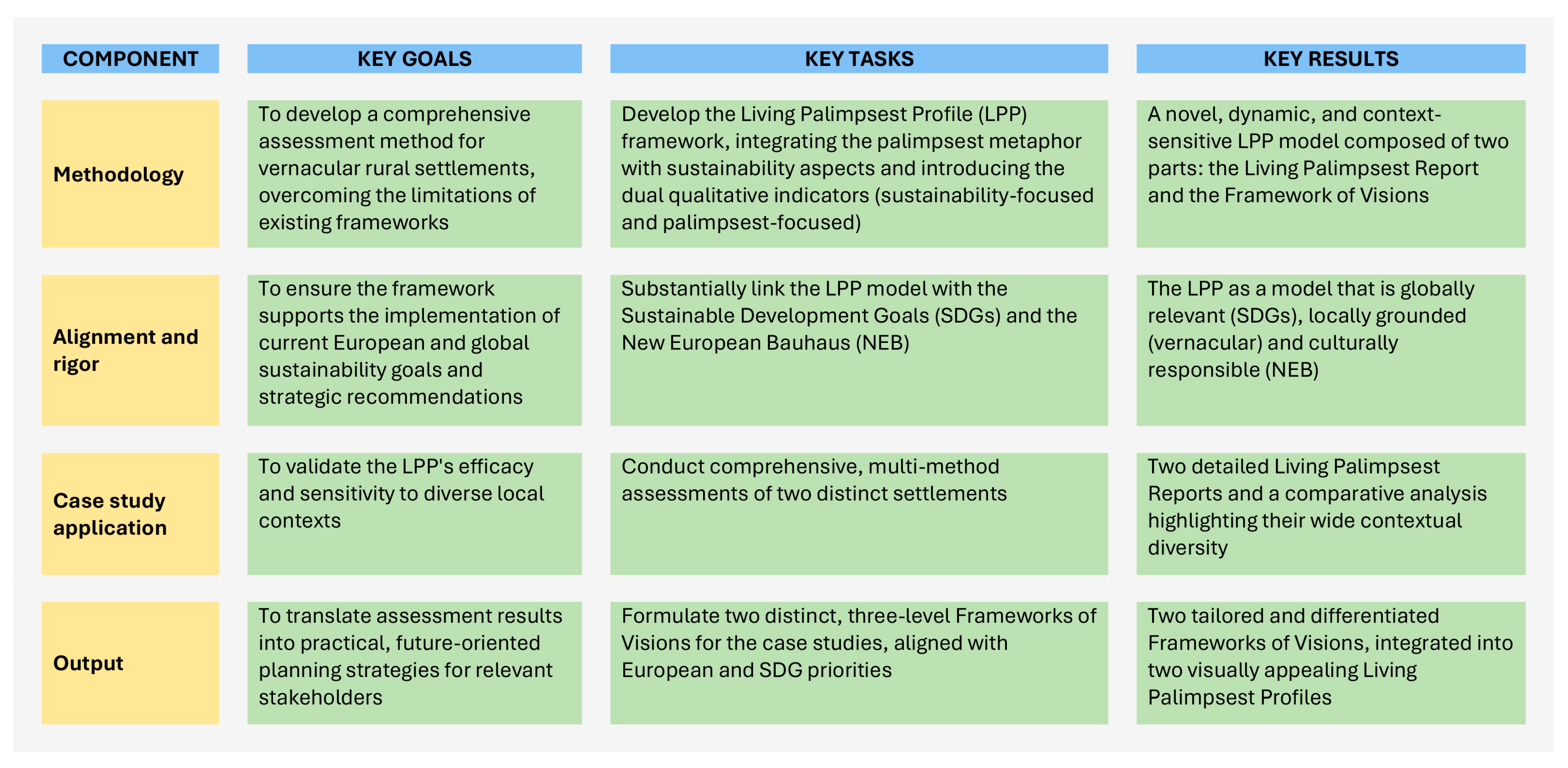
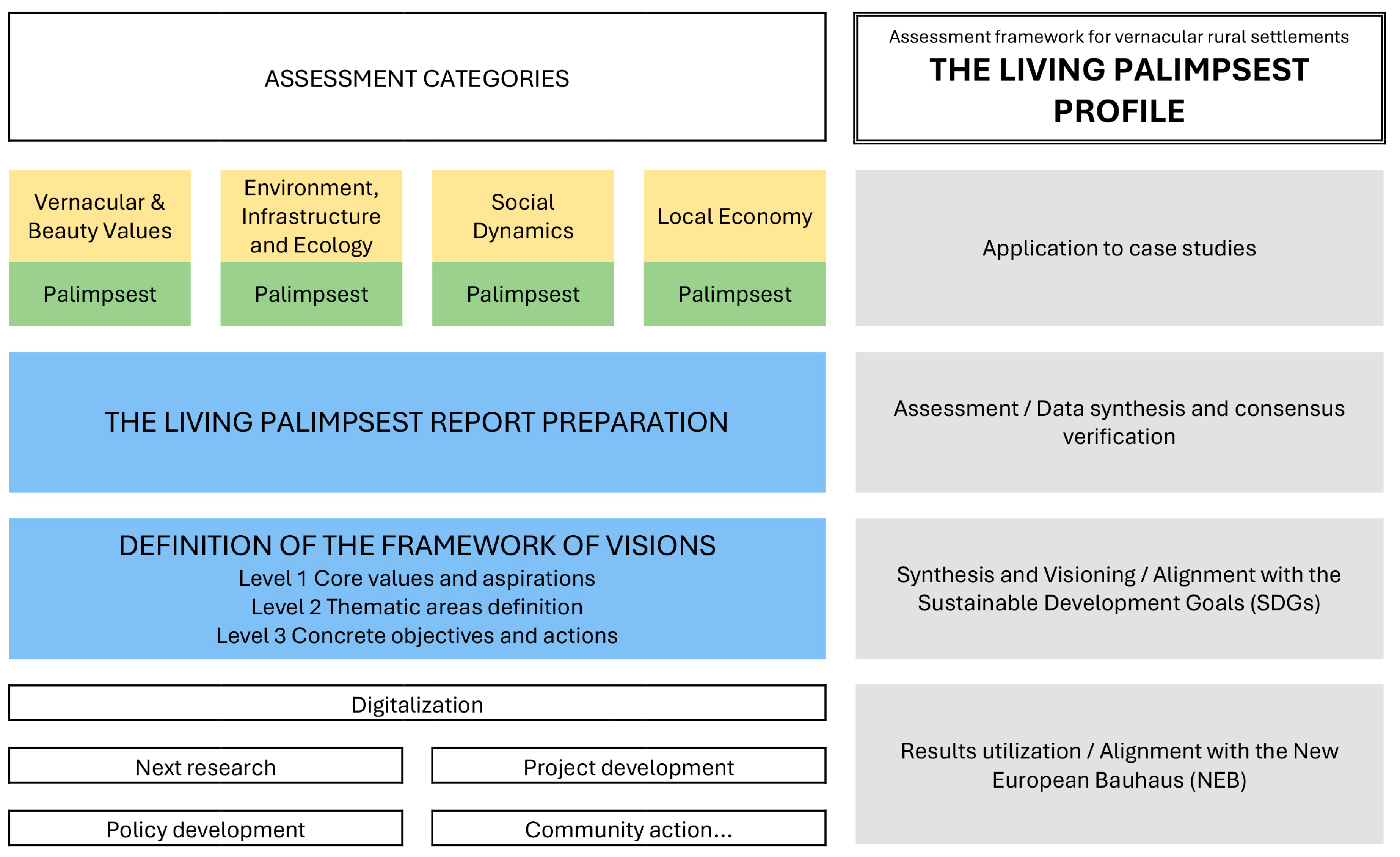
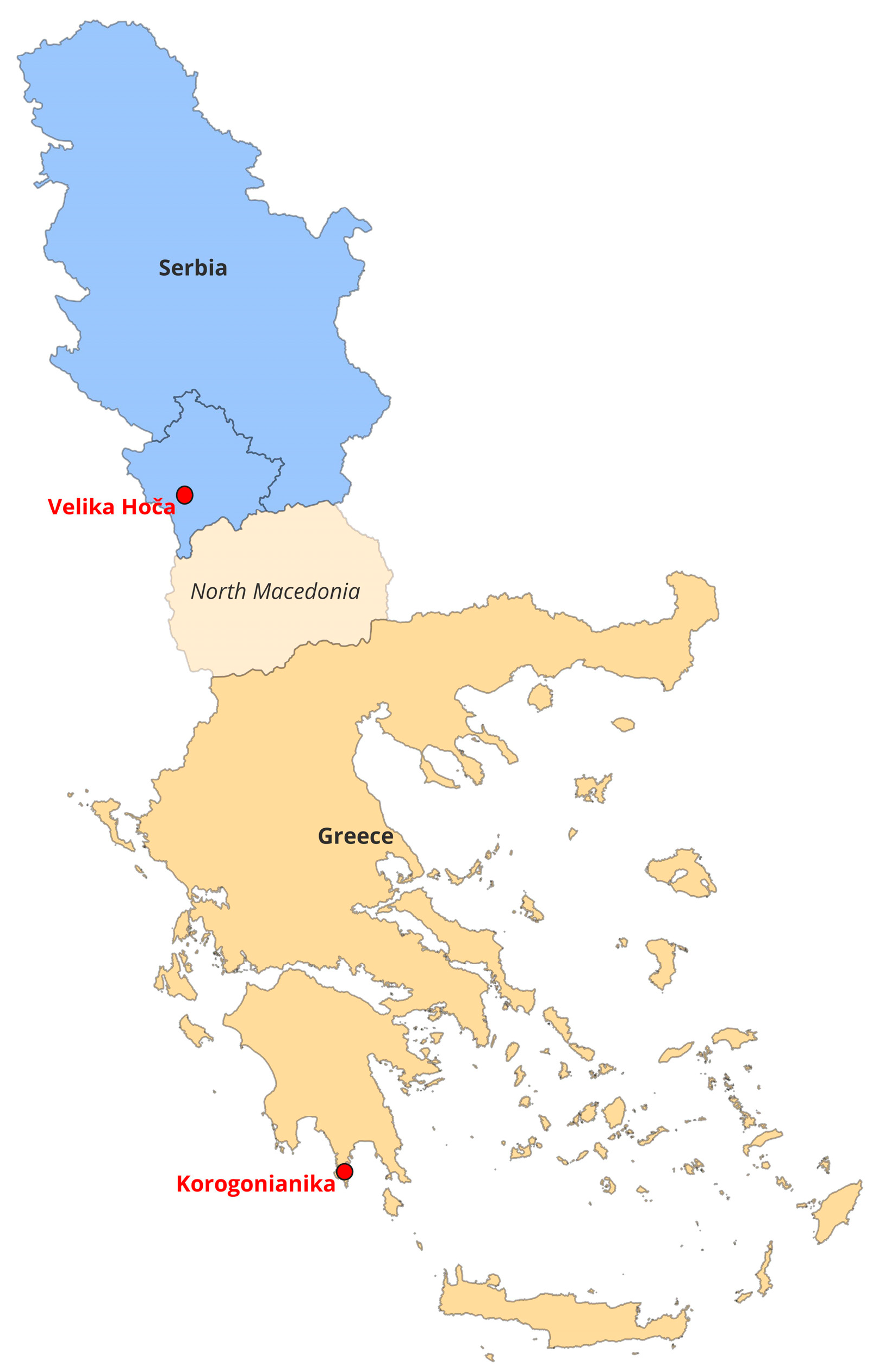
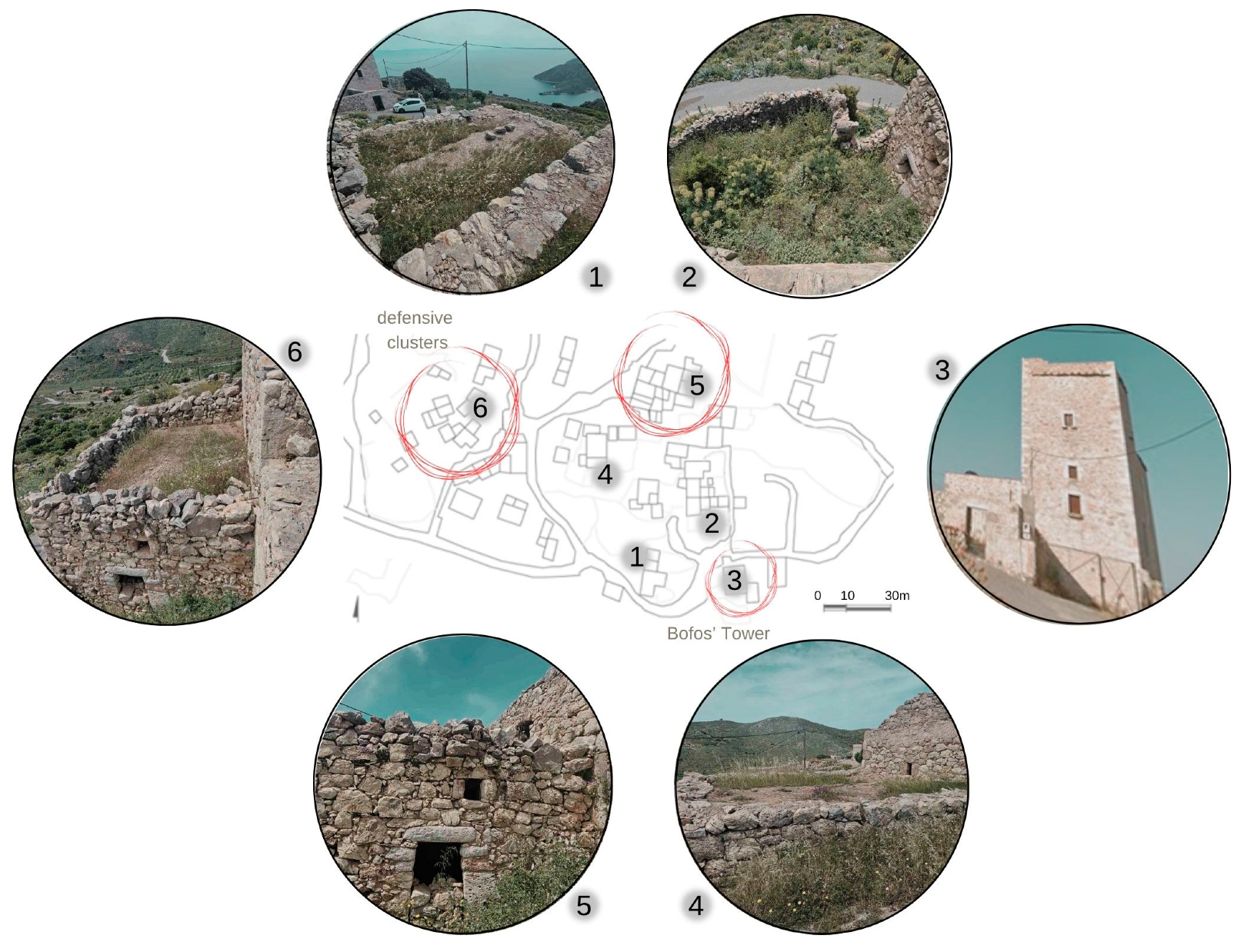

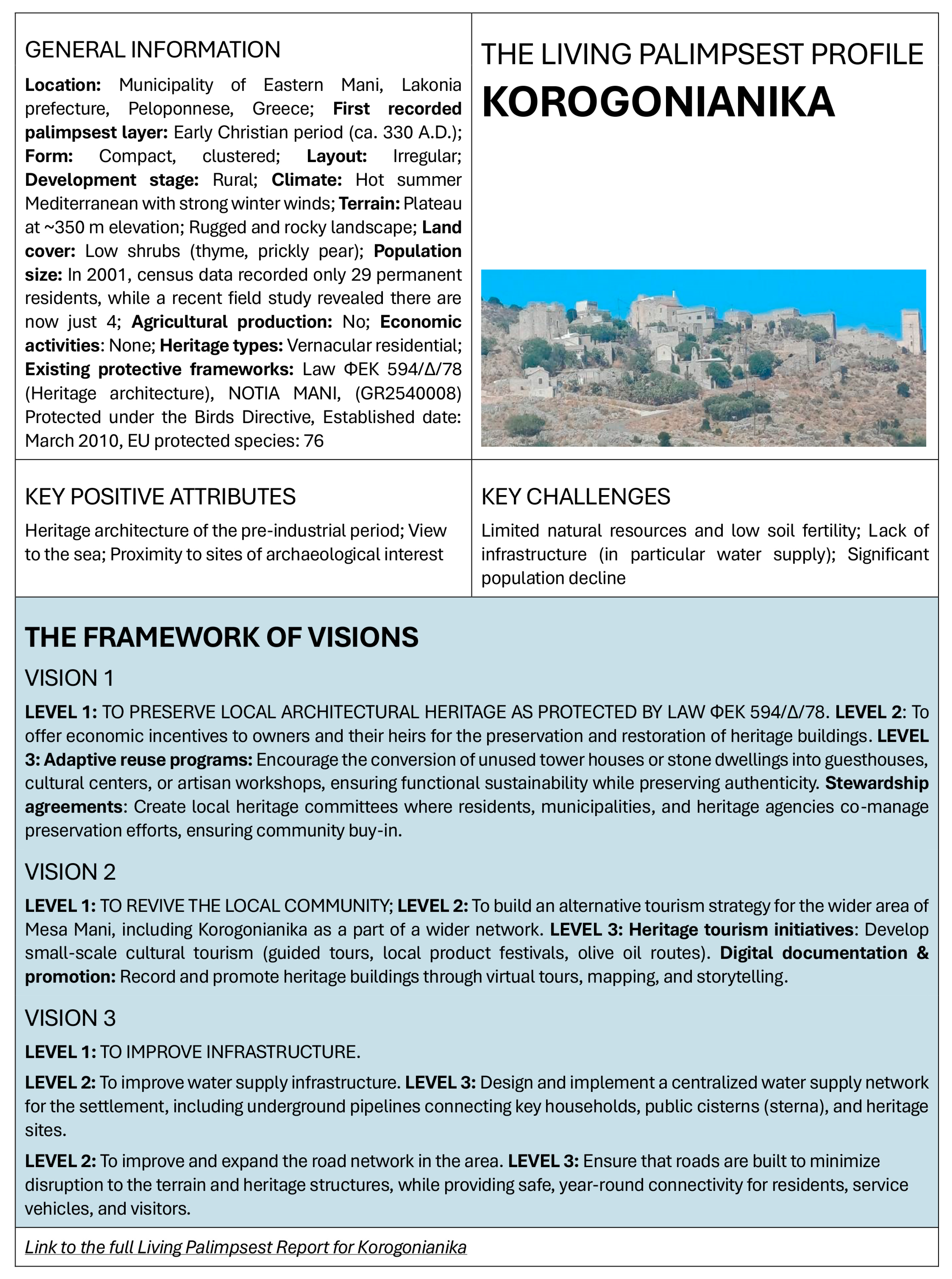

| Vernacular & Beauty Values | Palimpsest Vernacular & Beauty |
|---|---|
| What are the settlement’s key historical characteristics? What vernacular design principles are visible (e.g., street patterns, land use, functions, climate adaptation)? What are the key characteristics of vernacular architecture (e.g., historical period, materials, structures, climate adaptation, unique elements, socio-cultural reflection, space organization, ornaments, etc.)? Are there unique natural assets (e.g., relief elements, landscapes, views, or endemic living species)? Are there protected natural assets? Is there recognized architectural heritage? Have any vernacular architecture elements been officially recognized as heritage? Are there other distinguishing landmarks, aside from recognized heritage and vernacular structures, that contribute to the settlement’s distinctiveness? Are there regulations that protect tangible and intangible vernacular/heritage values? What are the defining characteristics of vernacular practices and knowledge in the community (e.g., in linguistics, arts and crafts, agriculture, and medicine)? Does the community recognize, value and utilize the vernacular beauty of their settlement in a responsible manner? What do the residents value/utilize the most? Are there cultural institutions in the settlement? | Are historical layers visible and legible? Are these layers well-documented and safeguarded? Are there signs that these layers are being discontinued/lost? Is the settlement’s vernacular character legible and dominant, or has it been partially or completely overwritten? Are vernacular architectural layers actively maintained and used, or are they decaying, leaving only traces? Have past interventions aimed to preserve/restore the original values or have they added a new, potentially conflicting layer? Have any spatial interventions erased or overwritten the original vernacular text? Are there any ongoing interventions to preserve vernacular and heritage values? Are these interventions in line with principles of ecological sustainability, circularity, and climate resilience? Is the intangible text of vernacular knowledge and practices still actively read and written, or has it become a faded, (un)documented layer of the past? Are young people involved in vernacular practices? How does heritage recognition affect the creation of new layers? Are the non-recognized physical traces from different historical periods being preserved? Are local cultural institutions dedicated to vernacular values? Do residents read and understand the different historical layers? Do they value the continuity or prioritize the creation of a new, separate text? Are there any historical vernacular practices, knowledge, or physical assets that are no longer present? If so, what are they, and what caused their disappearance? |
| Environment, Infrastructure and Ecology | Palimpsest of Environment, Infrastructure, and Ecology |
|---|---|
| Is the settlement easily accessible via road network and public transportation? What is the general state of the infrastructure (fresh water supply, energy supply, sewerage system, waste management, road network, digital technology, etc.)? Is the settlement considered a safe place to live? What is the intensity of traffic? Are there adequate signs and signals, and traffic calming measures? Is the settlement walkable (are pedestrian paths connected?) and bikeable? Are these sustainable mobility qualities fully utilized by the community? Are there sources of pollution (e.g., noise, light, heat generation, industrial facilities, landfills, agricultural activities)? Is the area rich in biodiversity, and is there a plan for its preservation? Are there plans for sustainable maintenance and development of the settlement? Is land use managed in an environmentally and socially responsible manner? Does new construction contribute to densification or dispersion? Is settlement resilient to the impacts of climate change? Is arable land impacted by climate change? What is the intensity of new construction, and are there regulations governing it? What are the key characteristics of modern buildings? Does new construction adhere to the principles of ecological sustainability (including energy efficiency), circularity, and climate resilience? Does new construction respect the natural qualities of the settlement? Is there a clear integration between the newly built and the natural environment? Does the settlement meet community needs? What types of spatial amenities are available? Does the settlement have central zone and/or main street? Are there mix use spaces? Are public and private common spaces (e.g., parks, playgrounds, clubs) being developed to foster community connection and interaction? Do all residents have fair access to essential services such as healthcare, education, and social support? What is the condition of these services? Is the settlement comfortable and accommodating for all generations of residents? Do residents care about environmental and circularity aspects (e.g., recycling, disposal of hazardous waste, construction waste management, agricultural waste, use of pesticides, energy savings, etc.)? Do they actively participate in settlement maintenance? Is there an organic farming? Is there a system for shared decision-making regarding the settlement’s development? Are these participatory processes transparent and inclusive? What is the share of green space in public areas? Are common green spaces easily accessible to all residents? What types of land are present in the settlement territory? How are the energy and water being utilized in agricultural activities? Are chemicals used in agricultural production? Are there local environmental regulations? What are the average lot size and organization? Is there any level of local self-sufficiency in terms of basic resources: water, food, or energy? | How do new transportation networks interact with the original pathways and access points? Do new layers preserve or overwrite historical circulation patterns? How does modern infrastructure (e.g., internet cables, new water systems) interact with older systems (e.g., public wells)? Are the older layers still visible and functional, or have they been erased? How do the historical and modern layers of a settlement—both social and physical—interact to create a sense of safety and security? Do new industrial or technological layers harm the historical and natural environment? How do new developments impact biodiversity? Are there efforts to preserve original ecological integrity? Did any native living species disappear? What are historical climate threats? Do development plans ensure that new layers maintain the integrity of the historical environmental and social fabric? What land use changes were occurring in the past? How does current land use respect the area’s historical use and environmental characteristics? Do historical land-use patterns still exist, or have they been replaced? Do the settlement’s construction layers—both old and new—work together to make the community resilient to climate change, or do new developments undermine the resilience built into older, traditional structures? What is the intensity of new construction on the settlement’s palimpsest? Are there regulations to ensure that new writing is legible and does not completely erase the historical text? Are there regulations that embed heritage and vernacular values and principles into the new construction (e.g., in terms distancing, materials, height, shape, openings, colors, texture, or decorative elements)? How does new aesthetics relate to traditional style—as a modern interpretation, a stark contrast, or an attempt to mimic the past? How do new developments and new modes of land use interact with the historical natural landscape? How do modern amenities and spatial layouts meet residents’ needs while preserving or building upon traditional gathering places and the community structures? How have different historical layers shaped what is now the central zone and/or main street? Are new common spaces being developed, and if so, do they build on a historical tradition of shared spaces? Are traditional gathering places (like an old square) still vital for social interaction? How do modern services layer upon or overwrite historical services (e.g., old schools, local shops)? Do new layers of development and infrastructure serve all generations, or are they creating a divide between older residents who identify with the past and younger residents who are part of the new identity? Do residents take an active role in maintaining different settlement layers, from preserving historical buildings to caring for the natural environment? Are new layers introduced through a collective, transparent, and inclusive process? Do all residents have a voice in settlement’s future? Did the size of the lot change over time? Does the lot organization preserve traditional rural character? How was resource self-sufficiency managed in the past? |
| Social Dynamics | Social Palimpsest |
|---|---|
| What are the key demographic trends, such as population growth or decline, and changes in demographic structure? What is the general educational profile? Is there an influx of new residents into the settlement? Is there a program to bring back the residents who left the settlement? Is there a visible pattern of collective community behavior and identity? Are there joint activities and events taking place? How do the residents get informed about those? What are the key sources of attachment and pride that residents feel for their settlement? How frequently do different generations or social groups interact? What are the primary modes of this interaction? Are there local associations, clubs, or organizations that are active in the community? Are there signs of social segregation, gentrification, or ghettoization that indicate a breakdown in social equity? Is there a fair access to the agricultural land? How do the public spaces facilitate social dynamics? Are these spaces inclusive and accessible to all groups? Do they foster a sense of collective identity and ownership? How do they manage potential conflicts between various users? To what extent is the community open and welcoming to new residents? To what extent is the community open to novel ideas, initiatives or experiments? | How did historical demographic trends influence the settlement’s evolution? How do current demographic trends affect the continuity of the traditional social fabric? Do new residents integrate into the existing community, or do they form a new, separate layer? Does the pattern of collective community behavior reflect the settlement’s historical identity? Are joint activities and events held in traditional places? Are there new social practices and events? If so, do they build upon or replace older traditions? Are people primarily attached to the settlement historical core, its natural environment, or its modern layers? Do social interactions help preserve traditional shared values, or do they highlight a divide between old and new? Are the historical roles of local groups still visible, or have they been supplanted by new ones? Do new and old community organizations operate independently, or do they share resources and members? Do older organizations influence how new groups function? Have any traditional associations disappeared? If so, what were the effects on the community’s structure? Have any old organizations been revived from community desire to reconnect with past? Do social divisions reflect or create new layers that are separate from the community’s historical structure? To what extent do public spaces reveal a palimpsest of social dynamics? How does the historical and cultural layers of these spaces influence social interaction? Has any traditional social practice disappeared? |
| Local Economy | Economic Palimpsest |
|---|---|
| What are the primary sources of income and economic activity in the community? Is the local economy experiencing growth, stagnation or decline? What are the key local economic resources (e.g., natural, human, or cultural)? Are there visible signs of economic fragmentation? Is the settlement economically self-sustainable in the long term? Is there a balance between public and private resources? Is there a diversity of ownership and investment models? Is there a problem with land concentration? Does the local economy’s sustainability rely on external support or subsidies? Are the values of the settlement actively promoted? Is the settlement attractive to visitors? Is there a tourism industry? What types of tourism are practiced (e.g., agritourism, religious tourism, etc.)? What is the capacity of local accommodation and other tourism infrastructure? What is the nature of local food production, including any certified products? Where are these products marketed? What is the nature of the local job market, and what job opportunities are available? What is the employment rate within the local population, and in which sectors are most people employed? Are there any tax incentives or relief programs for starting a new business? What is the level of entrepreneurship within community? | What are the key local historical economies? Did any traditional economic activity disappear? Is a traditional economy (e.g., farming, crafts) still active, or has a modern one (e.g., tourism, services) replaced it? Is the new economy building, isolating or eroding the old one (e.g., new businesses replacing old ones)? How do existing economic resources reflect historical activities? Are older resources being repurposed or abandoned? Is the long-term economic sustainability based on a single, dominant model or on the coexistence of multiple economic layers (e.g., traditional agriculture alongside modern tourism)? Is there a diversity of ownership models that reflects both traditional and modern economic layers? Do new investments and private resources work in harmony with older, public ones? Is there a balance between historical economic foundation and externally supported economic layers? Does settlement promotion focus on old or new layers, or a combination of both? Which layers attract the most visitors? Does tourism authentically represent vernacular values and heritage, or does it create a new layer? Are there economic programs to encourage investment in historic renovations? |
Disclaimer/Publisher’s Note: The statements, opinions and data contained in all publications are solely those of the individual author(s) and contributor(s) and not of MDPI and/or the editor(s). MDPI and/or the editor(s) disclaim responsibility for any injury to people or property resulting from any ideas, methods, instructions or products referred to in the content. |
© 2025 by the authors. Licensee MDPI, Basel, Switzerland. This article is an open access article distributed under the terms and conditions of the Creative Commons Attribution (CC BY) license (https://creativecommons.org/licenses/by/4.0/).
Share and Cite
Kosanović, S.; Tousi, E.; Gvozdić, M.; Marković, Đ.; Papantoniou, P.; Hloupis, G. The Living Palimpsest Profile: An Integrated Assessment Framework for Vernacular Rural Settlements. Land 2025, 14, 2130. https://doi.org/10.3390/land14112130
Kosanović S, Tousi E, Gvozdić M, Marković Đ, Papantoniou P, Hloupis G. The Living Palimpsest Profile: An Integrated Assessment Framework for Vernacular Rural Settlements. Land. 2025; 14(11):2130. https://doi.org/10.3390/land14112130
Chicago/Turabian StyleKosanović, Saja, Evgenia Tousi, Miloš Gvozdić, Đurica Marković, Panagiotis Papantoniou, and George Hloupis. 2025. "The Living Palimpsest Profile: An Integrated Assessment Framework for Vernacular Rural Settlements" Land 14, no. 11: 2130. https://doi.org/10.3390/land14112130
APA StyleKosanović, S., Tousi, E., Gvozdić, M., Marković, Đ., Papantoniou, P., & Hloupis, G. (2025). The Living Palimpsest Profile: An Integrated Assessment Framework for Vernacular Rural Settlements. Land, 14(11), 2130. https://doi.org/10.3390/land14112130











